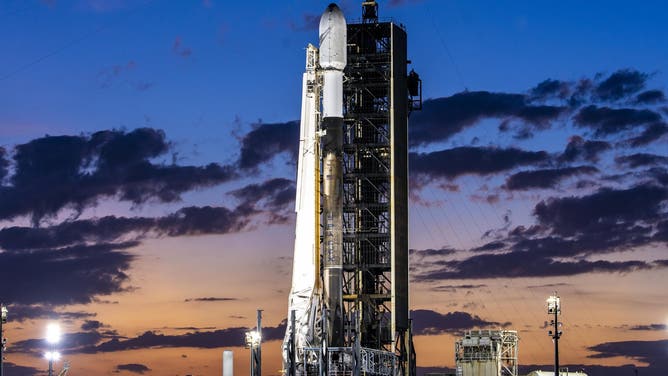SpaceX planned launch with Intuitive Machines’ Moon lander delayed to Thursday
Intuitive Machine's Nova-C Moon lander named Odysseus is slated to launch on Feb. 15 at 1:05 a.m. EST on a SpaceX Falcon 9 rocket from NASA's Kennedy Space Center. This will mark the second attempt this year by a commercial company to deliver NASA science the Moon.

A SpaceX Falcon 9 at Kennedy Space Center launchpad 39A ahead of the Intuitive Machines Nova-C launch. (Image:SpaceX)
A Houston-based company's attempt to land NASA science on the Moon less than a month after another company failed to reach the lunar surface as part of NASA's Commercial Lunar Payload Services program will have to wait just a little longer.
Intuitive Machines Nova-C Moon lander named Odysseus, or "Odie," was slated to launch early Wednesday on a SpaceX Falcon 9 rocket from NASA's Kennedy Space Center launchpad 39A. However, SpaceX and Intuitive Machines opted to delay the launch until Thursday due to a potential temperature issue with the spacecraft's methane fuel. Nova-C uses liquid methane fuel that is loaded onto the spacecraft via the SpaceX rocket prior to launch.
SpaceX and Intuitive Machines are now targeting Thursday at 1:05 a.m. ET
The mission known as IM-1 will deliver six NASA science payloads and commercial technologies to a region of the lunar south pole known as Malapert. It's also considered a potential landing site for NASA's Artemis III mission, the first astronaut mission to the Moon since 1972. The hexagonal-shaped lander is about the size of the British phone box made famous as the time-traveling Tardis in the "Dr. Who" science-fiction series.
Lunar landing remains challenging
No private company has ever successfully landed on the Moon. An attempt by Astrobotic's Peregrine lander, also part of NASA's CLPS initiative, was foiled by mechanical issues in orbit after launching on the first Vulcan rocket flight with United Launch Alliance. Peregrine burned up in Earth's atmosphere in mid-January, ending the first American Moon landing attempt.
Even government-managed mission success is not guaranteed. About half of all Moon landing attempts don't survive. In January, Japan became the fifth country to successfully land on the Moon.
NASA CLPS project scientist Susan Lederer told reporters on Monday that with commercial missions comes risk, but it will hopefully allow more NASA science to reach the Moon.

Intuitive Machines Nova-C lander, also known as Odie, within the SpaceX Falcon 9 fairings. (Image: SpaceX)
"Instead of one mission in a decade, it allows for more like 10 commercial missions to the Moon in a decade instead of 4 or 5 instruments in that one decade. It's more like 4 to 5 dozen instruments," Lederer said. "Being risk tolerant allows for high yield and high reward. And this is the beauty of CLPS. We'll learn from what doesn't work."
After the first CLPS mission with Astrobotic failed to reach the Moon, Intuitive Machines aims to achieve the first private Moon landing.
"As we prepare to embark on our IM-1 mission to the Moon, we carry with us the collective spirit of perseverance, fueled by the dedication and hard work of everyone on our team," Intuitive Machines President and CEO Steve Altemus said in a statement. "Their tireless efforts have brought us to this moment, where we stand on the precipice of history, humbled by the gravity of our mission, yet emboldened by the boundless possibilities that lie ahead."
JAPAN'S MOON LANDER BACK UP AND RUNNING ON THE LUNAR SURFACE AFTER FACEPLANT LANDING
Launch forecasters with the Space Force's 45th Weather Squadron predict a 90% chance of favorable launch weather for the overnight window.
SpaceX could try again on Friday if the launch is delayed.
If the spaceflight goes well, the lander could touch down on the Moon as soon as Feb. 22. It's a short trip to the Moon because Intuitive Machines' spacecraft does not require a lot of time in Earth orbit prior to heading toward lunar orbit.
NASA plans to carry live launch coverage of the countdown online and on NASA TV about 45 minutes prior to launch.
Intuitive Machines will stream a live video of the landing on its website.